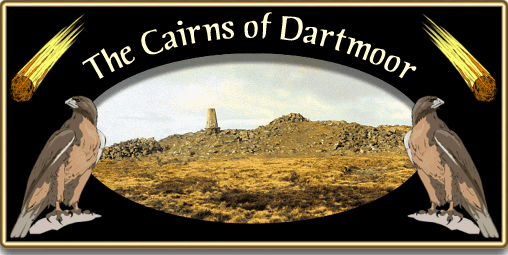
One thing Dartmoor is not lacking in is cairns, there are big ones, little ones, ancient ones and modern ones. It is impossible to look on a map of the moor and not see one somewhere. But what are there purpose? The explanation for the modern ones initially appears simple, they have been built to aid navigation in a featureless landscape. Walk along any of the old peat passes and you will see small piles of rocks marking out the now indistinguishable tracks. In November 2006 the Lake District National Park Authority asked walkers not to build or add to cairns as there is now a needless proliferation of them. In their (and many other people’s) opinion the cairns are detracting from the natural landscape and the sheer numbers are causing confusion when trying to navigate in adverse weather conditions. It also appears that the stones are being taken from foot paths which are then becoming the subject of serious erosion. But is it that simple? Why is it that on most notable peaks and mountains there are ever growing piles of rocks? There seems to be an innate urge in many people to add a rock in order to signify their visit. Could this be the original idea of the pre-historic cairn builders?
Archaeologists have come up with numerous suggestions as to what was the original significance of cairns. The general consensus is that they were either intended as memorials or as boundary markers and possibly navigational aids, it is even possible that there are a combination of all three. Another theory is that just before tribes went to war each warrior would take a stone and place it in a pile. Then if and when they returned they would take out their particular stone. Those that were killed obviously could not remove their stones so a cairn slowly formed over time and acted as a memorial for the fallen. In a way this is akin to the modern war memorial except instead of individual stones acting as a marker for the dead their names are carved on one big stone. I think this theory very unlikely in terms of Dartmoor because there are that many cairns which would mean that the prehistoric population was huge and that they were constantly killing each other.
The other problem associated with these enigmatic heaps of rocks is that they are very hard to classify, mainly because there are no uniform constructions but also many of the original stones have been removed for later building projects such as enclosure walls.
What is apparent on Dartmoor is that whatever their purpose they were a popular feature of the pre-historic landscape. The majority of the cairns date back to the Bronze Age although there are some earlier examples. The Dartmoor cairns have suffered greatly at the hands of the despoilers with many newtake walls, shelters and shooting butts having been built at their expense. Many have also suffered at the hands of the tomb raiders who dismantled them in the hope of finding hoards of treasure.
Gerrard (1997, pp. 54 -61) states that there are two main types of cairns – round cairns and ring cairns. By far the most common type is the round cairn with around 1,312 recorded examples. These tend to be a circular mound of stones which can vary from diameters of 1m. to 43m., they can stand from between 0.1m to 4m high The average Dartmoor cairn has a diameter of 8.83 m. and stands at 0.68 m. high. At the centre of the cairns was a burial that was either placed in a kist or a small pit. It has been suggested that both inhumation and cremations were placed under the cairns.
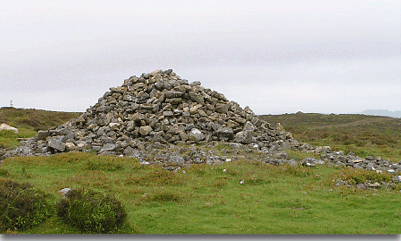
A Round Cairn on Black Hill
Excavations have revealed over 116 cairns that have associated kists and 16 which have yielded evidence of cremations in the form of burnt bone. Over 53 cairns have produced grave goods which includes; flint tools, flint arrowheads, pottery, quartz crystals, dress fasteners, bronze knives, bronze spearheads, beads, cooking stones, stone hammers, a stone amulet and a spectacular dagger pommel. Most of these artefacts have been dated to the Early Bronze Age which places them to between 2300 and 1400 BC. The dagger pommel was retrieved from a cairn on Hambledon Hill in 1877 and Pearce (1978, p.47) considers that the dagger pommel is:
“The most splendid ‘Wessex’ object from Devon… which was unfortunately destroyed during the bombing of Plymouth in 1943. Old records show that it measured 2.3 by 1.3 inches, cut from a single amber piece. The upper part was oval and the lower part fitted with a tang so it could be fastened to the weapon’s hilt. More remarkable still, the amber surface was enhanced by the drilling of hundreds of tiny close holes set in a cruciform pattern on the upper surface into which were inserted pins of gold wire. A segment had been broken off the side and the piece repaired by the attachment of an amber piece with gold pins before it was deposited in the grave.“
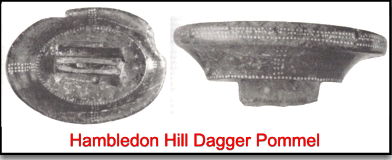
The same cairn also revealed a cremation and a bronze dagger so considering the high status grave goods this surely must have been the burial of a very esteemed person.
Ring Cairns mostly consist of a ring-bank of stone or earth which encompasses either an open area or a mound, in some cases a tor outcrop. There are around 212 known examples of ring cairns on Dartmoor and the internal diameters range from 1.7m to 41m. The heights of the ring bank vary from about 0.1 m. to 4 m.
Butler (1997, p.166) considers that although there is no defining design there are some similarities to be found amongst the surviving cairns on Dartmoor. Firstly, many of the summit cairns have small, natural rock piles at their centre which could have been either to emphasise the structure. It would also save on the collecting of small rocks with which to build the cairn. It also appears that cairns with a diameter of more than 15 m. are usually located on the peaks and hilltops of the moor where they were a focus for additional burials. There is also a class of cairn that has been described as ‘prestige cairns’, these have a diameter of more than 20 m. and tend to be located at highly visible places. These cairns tend to be located on the moorland edges and are in spots that are away from any settlement, they are also intervisible from other nearby monuments. This may have been to impress any neighbouring groups and possibly to signify to any strangers that the area was already occupied. These large cairns would have taken a great deal of social organisation to construct which would have necessitated a ruling class. In itself this would be reflected in the prestige cairns which clearly spelt out the fact that the head man had control over a large workforce.
The smaller cairns tended to be located on lower ground which made them more visible from the lower slopes. Where a cluster of 5 or more cairns is present they are classed as a ‘cairn cemetery’. Grinsell (1984, p.19) also notes how the smaller cairns tend to be located near rivers and streams and most have a central kist. Parker Pearson (2005, p.90) also points out that some of the stones for the smaller cairns came from field clearances prior to cultivation which brings us nicely to a third type of cairn – the ‘clearance cairn’. These are usually found at the sides of fields or enclosures and can vary in both size and date. Whenever a field was required for cultivation the first step had to be the removal of any surface rocks and stones. Some of these were large boulders which in later times were blasted out of the ground, prior to that a great deal of labour was needed to accomplish the task. All the rocks etc were the piled up on the edges of the enclosures thus creating a large heap or ‘cairn’. Some of these clearance cairns can be huge as shown in the picture below:
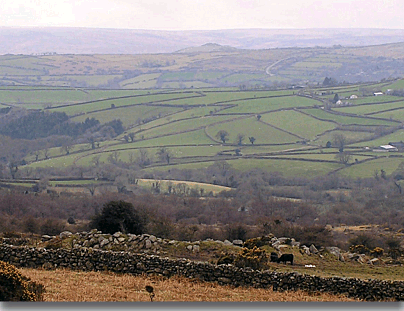
In later history the cairns have been used to define various boundaries which range from the Forest of Dartmoor down to local parish and manorial limits. In some cases the cairns have taken on specific place-names within the landscape other than the normal descriptive names:
| Name of Cairn | Grid Ref. | Also Known As | ||
| ARTHUR’S OVEN | SX 6715 8129 | AKA King’s Oven. | ||
| COTTAGE LOAF, THE | SX 6653 6517 | AKA Eastern Whittaburrow | ||
| FURNUM REGIS | SX 6716 8129 | AKA Kings Oven | ||
| GIANT’S BASIN | SX 5920 6694 | |||
| GIANT’S GRAVE | SX 7676 8740 | |||
| HARTSBERRY | SX 7412 7623 | AKA Seven Lords Land | ||
| HEY TOR BOUND, THE | SX 5518 8457 | Bond mark of Wilsworthy Manor | ||
| HEAP OF SINNERS | SX 6622 6690 | AKA. Huntingdon Barrow | ||
| KING’S OVEN | SX 6715 8129 | |||
| PENNY PIE BURROW | SX 7388 7472 | |||
| RING O’ BELLS | SX 5214 8287 | |||
| SEVEN LORDS LAND | SX 7412 7623 | |||
| SUBMARINE, THE | SX 6653 6517 | AKA Eastern Whitaburrow |
Other indications of a cairn in Dartmoor place-names is the suffix , barrow, burgh, burrough and corn (Celtic Carn).
Quite often summit cairns are accompanied by Ordnance Survey trig points which is hardly surprising as both command prominent high points. This in itself reinforces the theory that the cairns were built on highly visible promontories. The other strange fact is that there are very few legends attached to the cairns which when considering their sepulchral origins should mean some story of ghosts or demons.
Over recent years the prehistoric cairns have suffered varying degrees of damage, this has resulted in the stones being used to build mounds and temporary shelters both of which place the ancient monuments at risk. The Dartmoor National Park Authority clearly place the blame for this at the feet of visitors but I know of instances where the military have have been just as guilty. The main concern is that if the stones continue to be removed from the cairns then eventually the archaeology will be exposed which clearly could be a problem. If anybody is found taking stones from a cairn it could also be a big problem for them as it an offence to remove stones from a scheduled monument without prior consent.
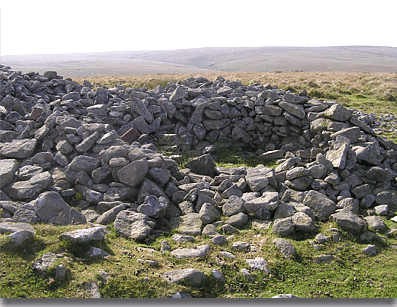
A modern ‘shelter’ at Eylesbarrow cairn – 2007
In 2005 the Dartmoor Preservation Association began a ‘Cairn Restoration Project‘ whereby 21 damaged cairns on the south moor were identified and ear-marked for survey and repair. By 2007 the project was well underway with the Three Barrows cairn being repaired which was the biggest of the cairns so far tackled.
Bibliography.
Butler, J. 1997 Dartmoor Atlas of Antiquities – Vol. V, Devon Books, Exeter.
Gerrard, S. 1997 Dartmoor, Batsford, London.
Grinsell, L. V . 1984 Barrows in England & Wales, Shire Pub., Aylesbury.
Parker Pearson, M. 2005 Bronze Age Britain, Batsford, London.
Pearce, S. 1978 Devon in Prehistory, Exeter City Museums, Exeter.
 Legendary Dartmoor The many aspects past and present of Dartmoor
Legendary Dartmoor The many aspects past and present of Dartmoor

Of particular interest to me are what really just look like piles of rocks but which suggest a purpose. We have three piles of rocks on the land here, where I live – eastern New York State, USA, very near the Vermont border. The piles are on average 15 to 30 feet in diameter and maybe 10 to twenty feet high. It has been a common practice for farmers to remove rocks when preparing land for cultivation but it is counterproductive to leave them in huge piles on the field. So what might these be? Who would come take a look? Before European colonizing (imperializing) many native peoples lives and hunted in our region. Thanks for any help you might offer.
You will find this link useful – http://www.nativestones.com/cairns.htm